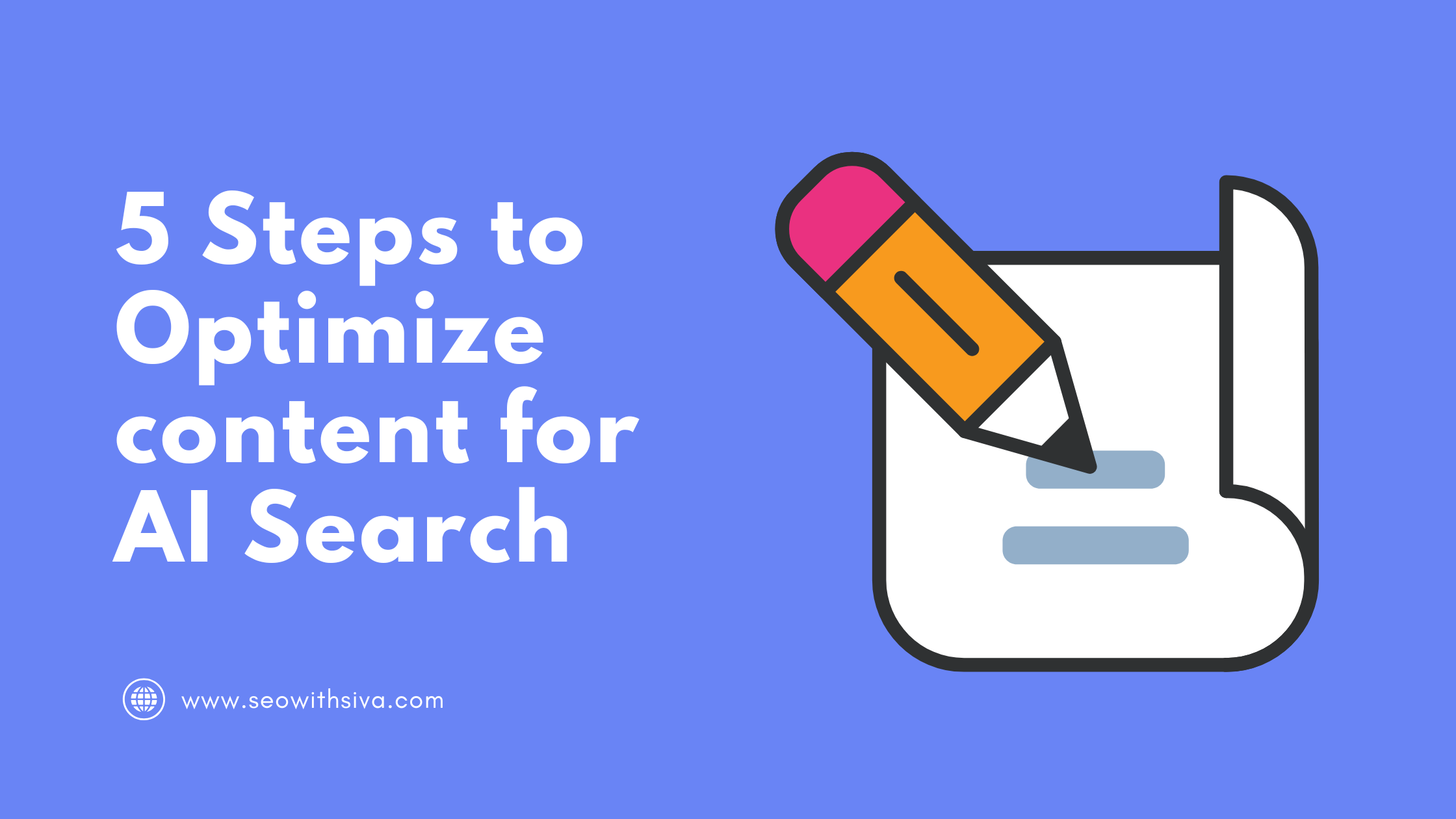The way people search online is changing – fast. Instead of typing short keywords into Google, more users are turning to AI tools like ChatGPT, Google’s AI Overviews, Perplexity, and Gemini to ask complex, specific questions. And these AI platforms are responding with answers that pull content from websites but not always from page-one Google results.
That’s where GEO (Generative Engine Optimization) comes in.
GEO is the new SEO: it’s about optimizing your content so it can be found, cited, and quoted by AI search engines. And unlike traditional SEO, you don’t need to outrank the biggest websites to win. You just need to be helpful, structured, and visible in the right places.
If you’re a blogger, business owner, content creator, or digital marketer, this guide is for you. Below are 5 easy, actionable steps to start optimizing your site for AI-driven search without needing to become an SEO expert.
Step 1: Audit Your Existing content for AI Search
Before creating anything new, take a good look at what you already have.
AI models like ChatGPT and Google AI Overviews don’t just look for high-ranking content they look for well-structured, useful content that answers specific questions. That means some of your existing blog posts, service pages, or product reviews might already be great candidates for AI citations you just need to fine-tune them.
What to Look For During a Content Audit:
- Clarity: Is the content easy to read and understand?
- Structure: Are you using headings (H1, H2, H3) to break up content logically?
- Direct Answers: Does the page provide clear answers to common or niche questions?
- Length: Is the content too short to be useful, or too long and hard to scan?
- Relevance: Does it still reflect your audience’s current needs and search intent?
- Readability: Is it written in plain language that both people and AI can easily interpret?
Tools You Can Use:
- SEMrush AI Toolkit – to see how often your pages are mentioned by AI.
- ChatGPT or Perplexity.ai – to test if your content is showing up in answers.
- Google Analytics – to identify your highest-traffic pages and optimize those first.
Tip: Start with your top 5 – 10 pages. Focus on high-traffic blog posts, cornerstone content, and pages related to your main offers or expertise.
Step 2: Update and Improve Key Pages
Once you’ve identified the pages worth optimizing, the next step is to make them AI-friendly.
Remember, AI tools are scanning your content to find direct, structured, trustworthy answers. You’re not just writing for Google anymore – you’re writing for generative engines that pull snippets, summaries, and takeaways from well-organized pages.
Key Updates to Make:
1. Use Proper Heading Tags (H1, H2, H3)
Organize your content like a teacher would organize a lesson:
- One H1 per page (your main title)
- Use H2s for major sections
- Use H3s for subtopics or related ideas
This not only helps users scan quickly, but also helps AI understand the hierarchy of information.
2. Add FAQs
Include a short FAQ section near the end of your post or service page. Make sure each question is written like something a real user would ask.
Example:
Q: What’s the best way to grow a Pinterest account for a small business?
A: Focus on pinning high-quality, niche content consistently and use keyword-rich descriptions. Group boards and Pinterest SEO also help.
AI tools love FAQs because they match the natural format of user queries.
3. Lead with the Answer
Instead of writing long introductions or burying your point, start with a direct answer to the main question your content addresses. Then, provide details, examples, or steps afterward.
Example:
Old intro: “Pinterest is a platform with millions of users, making it great for marketing…”
New intro: “To grow on Pinterest, you need a mix of SEO-friendly pins, consistent posting, and niche-focused boards. Here’s how to do it…”
4. Summarize with Takeaways
At the top or bottom, include a short “TL;DR” or “Key Takeaways” list. AI often pulls summaries directly from these areas.
Step 3: Be Active in Online Communities
AI tools don’t just cite blog posts they also love user-generated content (UGC) from platforms like Reddit, Quora, Stack Exchange, and niche forums.
Why? Because this kind of content is:
- Question-based
- Honest and specific
- Conversational
- Full of real-world context
By participating in these communities, you increase your chances of being quoted by AI search tools. But don’t spam – AI is smart enough to spot promotional fluff.
How to Do It Right (The 80/20 Rule):
- Be helpful 80% of the time – Share advice, answer questions, and engage in real discussions.
- Promote your content 20% of the time – Only link to your site when it truly answers a question or adds value.
🛠 Where to Start:
- Reddit: Search for threads in subreddits relevant to your industry.
- Quora: Look for unanswered questions related to your niche.
- ProductHunt or IndieHackers: If you’re in tech/startups.
- Specialized forums: Find where your target audience hangs out (e.g., photography forums, parenting groups, health communities).
Pro Tip: Include your brand or name in your Reddit bio or Quora profile, even if you don’t link out every time. AI may still associate your contributions with your domain.
Step 4: Pitch Your Brand to AI-Friendly Articles
AI tools often pull answers from listicles, reviews, and “Best of” posts—especially those on trusted, high-authority sites.
If you can get your product, service, or brand included in one of these roundup-style posts, there’s a much higher chance it’ll be cited in AI answers.
Here’s How to Do It:
- Search for roundups in your niche
- Google examples like:
- “Best tools for Pinterest marketing”
- “Top project management tools 2025”
- “Best platforms for small business websites”
- Check which of these appear in AI answers
- Use ChatGPT or Perplexity to search those topics.
- Note which blog posts or sites are being cited.
- Reach out with a pitch
- Send a short, personalized email to the author or editor.
- Offer something valuable like:
- A unique feature of your product
- A new case study or data
- A free trial or demo
- Create your own listicle
- If you can’t get listed on someone else’s post, create your own expert roundup or comparison. AI may pick it up especially if it’s well structured and unbiased.
Step 5: Collect and Display Detailed Reviews
Generic testimonials like “Great service!” don’t help much. But a detailed review that says what problem you solved, how you did it, and what changed for the customer? That’s AI gold.
How to Get Better Reviews:
- Ask happy clients to explain:
- What challenge they were facing
- What you did to help
- What the result was
- Use specific prompts like:
- “Can you describe how our tool saved you time?”
- “What was your biggest win from using our service?”
Best Places to Collect Reviews:
- Google Business Profile
- G2 or Capterra (for SaaS and B2B)
- Trustpilot or SiteJabber
- Your own website (use schema markup so reviews are crawlable)
Bonus Tip:
Add structured data (review schema) so that AI and search engines can easily “read” the reviews and understand their context.
Conclusion:
The rise of AI search isn’t something to prepare for in the future – it’s already happening. Platforms like ChatGPT, Perplexity, and Google’s AI Overviews are actively reshaping how people discover information online. The good news? You don’t need to be a big brand or rank #1 on Google to succeed in this new era.
With Generative Engine Optimization (GEO), the playing field is more level than ever. AI tools prioritize clear structure, useful answers, and real-world insights – not just domain authority or backlink profiles. That gives smaller businesses, creators, and experts a powerful opportunity to get noticed.


